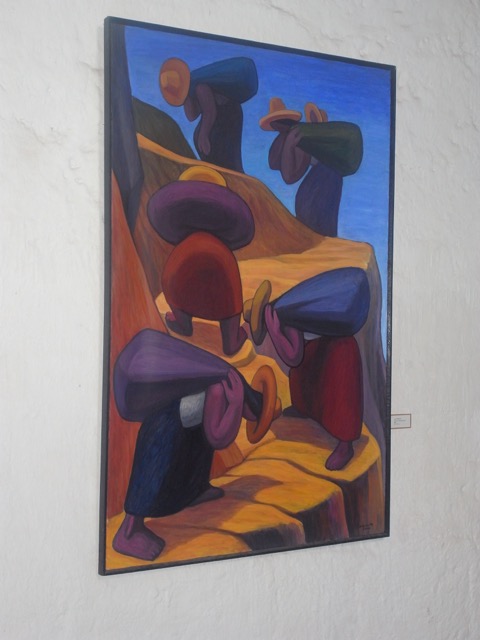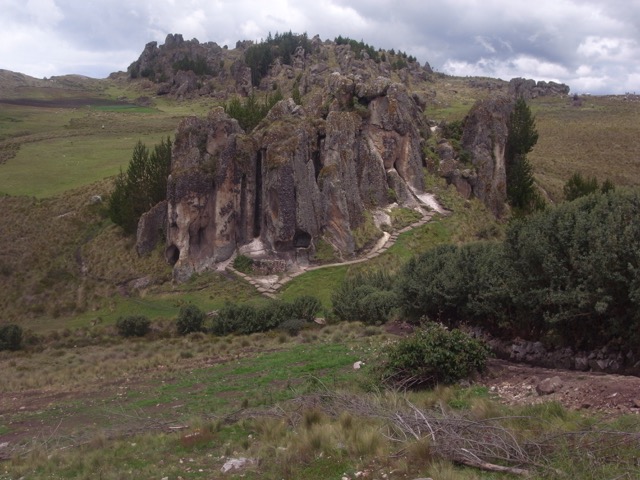A Guide To Cajamarca
View over Cajamarca from Cerro Santa Apolonia.
Cajamarca is a big city nowadays, with a number of mining projects in the area, but is still the most attractive, historic town in the North, full of exquisite Baroque churches and old mansions from Colonial times.
At a moderate elevation of 2,650 m (8,695 ft), it is graced with a pleasant climate and surrounded by a fertile valley known for its dairy farming.
The campesinos (farmers) working the lands are known for their extra-wide-brimmed straw hats, which are symbolic of the region.
A local band, in traditional garb, process during Carnival.
Cajamarca is also the venue of one of Peru's liveliest Carnivals, celebrated over the course of an intense, three-day weekend, in the month of February or early March.
This has earned it the official title of Capital of the Peruvian Carnival.
History of Cajamarca
It was in Cajamarca, in 1532, that a small group of Spanish Conquistadores and the Inca leader, Atahualpa, first met, followed by a surprise attack … and the capture of Atahualpa.
An information panel describes the meeting between Atahualpa & the Conquistadors.
The Spanish then demanded a huge ransom to free the Inca leader, which was delivered to fill up the so-called Cuarto de Rescate (Ransom Room) - twice with silver and once with gold.
Unconcerned with the artistic merit of the work, the Spaniards melted it down into 6,000 kg (13,200 lbs) of gold and 12,000 kg (26,400 lbs) of silver bullion - worth more than $200 million at today’s prices!
Despite his minions complying with the ransom demands, Atahualpa was executed by the Spaniards the following year, which was one of the key moments of the war that led to the end of the Inca Empire.
The red line in The Ransom Room.
The Ransom Room is the only structure from Inca times that survived the raging conflict: one room, of Inca stonework, with a red line drawn at around 2m (6.6 ft) high, indicating the height at which the room was to be filled with gold treasures.
Not really much to indicate the change of regimes, religions, language and worldview that the execution of Atahualpa signified!
Luckily, Cajamarca has a lot else to offer, even if its remarkable place in history is not abundantly obvious or celebrated.
Attractions in Cajamarca
El Conjunto Monumental de Belén features the Church of Belen, built of light-colored volcanic rock. The Baroque façade, begun in the 17th century, is busily elaborate and the finest example of its type in Cajamarca.
The church has a carved wooden pulpit decorated with carvings of various saints, a gold-plated altar, and a cupola representing the heavens supported by eight stalwart angels.
Look for the unusual carving of an exhausted Christ sitting with legs crossed and resting his chin on a double-jointed hand.
At the back of the courtyard, the church-run Hospital de Varones (Men’s Hospital) also dates back to the 17th century; its grim, cell-like, patient cubicles were used into the latter half of the 20th century. There is a small exhibit of early medical instruments.
The right-hand side of the former hospital used to be the kitchen and dispensary; now it is an Art Gallery with a permanent collection of vivid, oversized canvases of campesinos and countryside by the famed Cajamarquiño painter, Andrés Zevallos (b. 1916).
The Ethnographic Museum is in what used to be the church-run Hospital de Mujeres (Women’s Hospital). Also built of volcanic rock, it features a façade of flowers, fruits, birds, angels, and, high on pillars above either side of the door, a pair of sculpted women with four breasts, supposedly representing fertility.
Inside, the former hospital has a disappointingly small collection of artefacts labelled in Spanish.
Cajamarca’s Plaza de Armas at dusk.
The spacious Plaza de Armas has a central iron fountain dating from 1692.
The Cathedral, begun in the late 17th century, was deliberately built without a tower to avoid Colonial taxation. Spain levied taxes on churches when they were completed; lacking a tower, the cathedral was 'unfinished'!
Its baroque façade and gold-plated altar are typical of the period.
Church of San Francisco & Capilla de la Dolorosa exterior.
Opposite, the more interesting Church of San Francisco has a museum and catacombs. Although parts of the church predate the cathedral, the towers were not added until the mid-20th century.
Adjoining the church on its right is the Capilla de la Dolorosa, a lovely chapel featuring a painting of the Virgin Mary with her heart pierced with seven swords.
Shrine on Cerro Santa Apolonia.
From the Plaza, a pedestrian street climbs steeply southwest via zigzagging steps to Cerro Santa Apolonia, a hilltop with a fine view, chapel, garden, and carved rocks, one of which is said to have been a seat used by the Inca to review his troops.
Environs of Cajamarca:
Cumbemayo, in the highlands southwest of Cajamarca, is an area of naturally eroded geological formations and man-made canals and petroglyphs dating back three millennia.
The Ventanillas de Otuzco & Ventanillas de Combayo are pre-Inca necropoli of niches carved into a rocky hillside, containing human bones.
There are a number of quaint, traditional villages worth visiting in the attractive rural countryside, the most famous being Porcon, an economically-successful farmers' community, amidst rather un-Peruvian pine plantations.
The hot baths at Baños del Inca.
The best known local trip, though, is to the Baños del Inca 6 km (4 miles) east of Cajamarca along the road to Chachapoyas.
These natural hot springs, where Atahualpa bathed before his fateful encounter with Pizarro, have been developed into a deservedly popular complex including public baths, private pools, saunas and massages.
On weekends and holidays, it can get very busy. For a more intimate way to enjoy the springs, there is a resort hotel set in farmland, Laguna Seca, nearby.
A monolith at Kuntur Wasi.
An hour and a half west of Cajamarca lies Kuntur Wasi, an important archaeological site from the Chavin era.
There is not that much to see, as all excavated structures have been covered up again, to secure their protection, but archaeologists have found graves here with the oldest golden objects known from the Americas. These can be seen at the local site museum, along with impressive carved monoliths - replicas have been placed at the site.
How to visit Cajamarca:
Cajamarca airport has many flights to and from Lima, and so many people come here for a few days to enjoy the Colonial architecture and laidback atmosphere, with the option to stay at some unique properties.
PeruNorth’s Cultural Cajamarca itinerary takes in the highlights of the city - and its surroundings - over four or five days, staying right in the centre.
Cajamarca is also the end point of our Chiclayo - Cajamarca 6D / 7D / 8D and Hidden Chachapoyas 7D land itineraries; and our epic 21-day Great Northern Birding Route trip.
Moreover, we can easily customise an itinerary to include Cajamarca. Just ask us how.
Market stall holders in Cajamarca.























